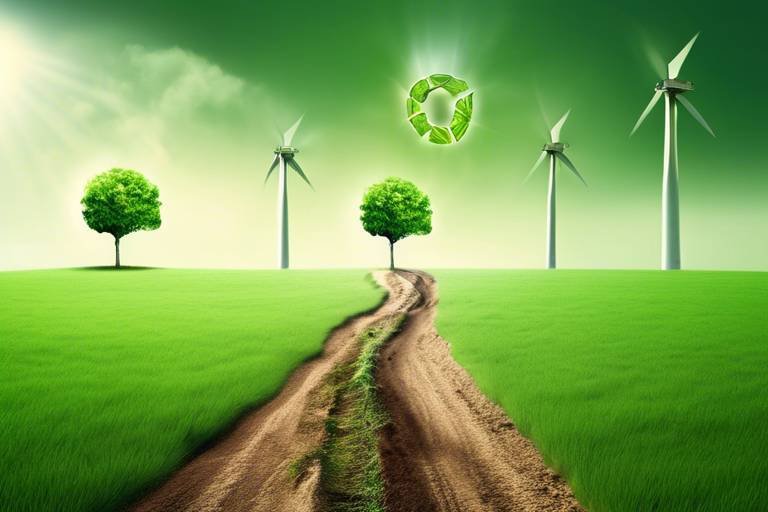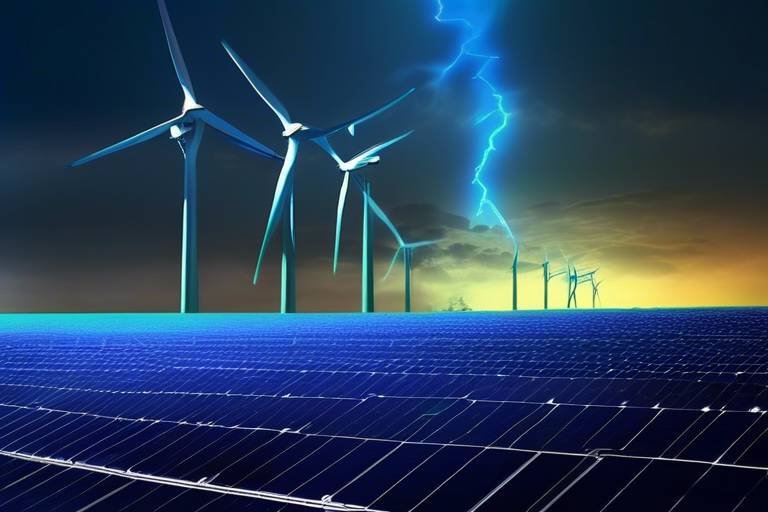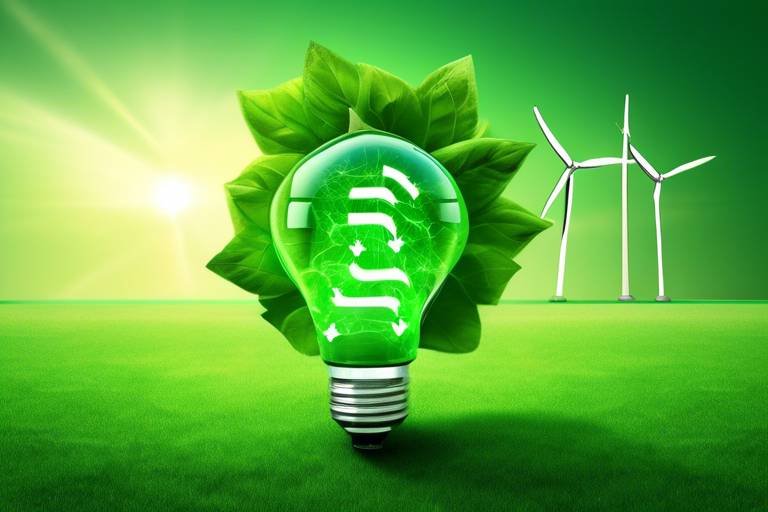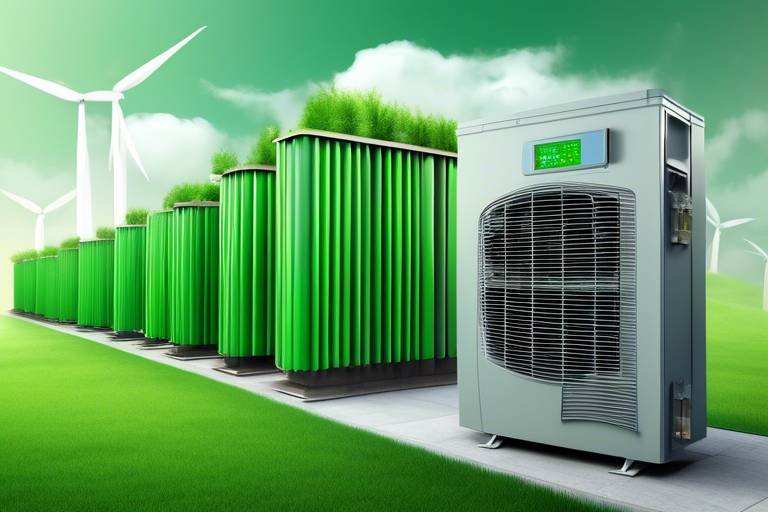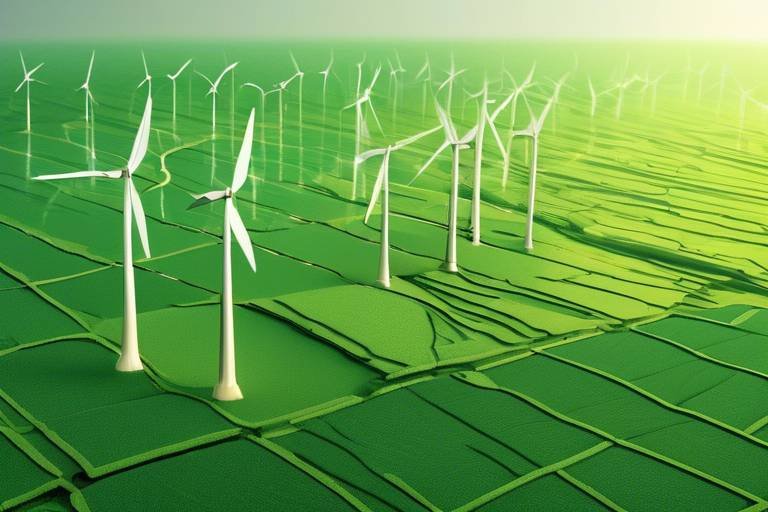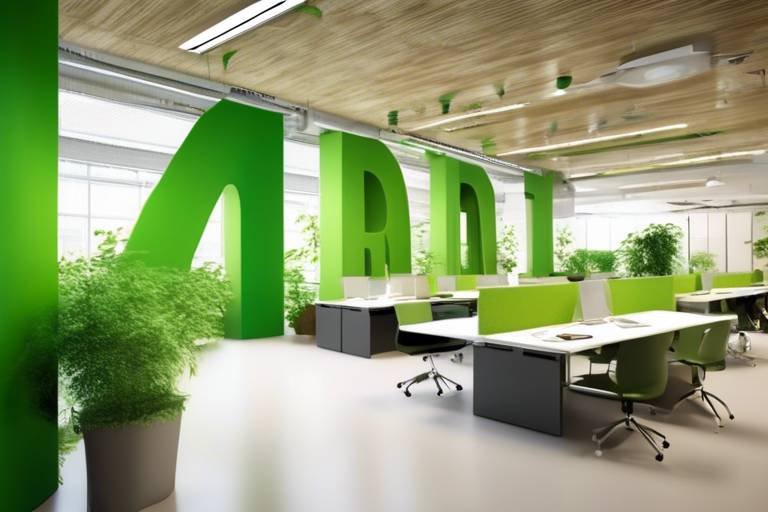Making a Switch - How to Transition from Traditional to Green Energy
Transitioning from traditional energy sources to green energy is not just a trend; it's a vital step towards ensuring a sustainable future for our planet. With the increasing awareness of climate change and its devastating effects, many individuals and businesses are realizing the importance of making this switch. But what does it really mean to transition to green energy? It involves embracing renewable energy sources such as solar, wind, hydro, and geothermal, which have a significantly lower environmental impact compared to fossil fuels. This article will guide you through the essential steps and considerations for making this crucial transition, highlighting the benefits, challenges, and practical tips for everyone involved.
So, what exactly is green energy? In simple terms, green energy comes from natural sources that are constantly replenished. This includes sunlight, wind, rain, tides, waves, and geothermal heat. Unlike traditional energy sources like coal, oil, and natural gas, which can deplete and cause significant environmental harm, green energy is sustainable and has a much lower carbon footprint. Understanding these concepts is crucial for anyone considering a transition from traditional energy sources. It’s not just about saving money; it’s about preserving our planet for future generations.
The benefits of transitioning to green energy are numerous and compelling. From reducing your carbon footprint to achieving energy independence, the reasons to make the switch are as diverse as the energy sources themselves. Here are some of the key benefits that motivate individuals and organizations to embrace green energy:
The environmental benefits of green energy are significant and far-reaching. By reducing reliance on fossil fuels, we can drastically lower greenhouse gas emissions, which are a primary driver of climate change. Imagine a world where the air is cleaner, wildlife thrives, and natural resources are preserved. This is the future that green energy can help us achieve. The transition to renewable energy not only contributes to a healthier planet but also promotes biodiversity by protecting vital ecosystems.
One of the most immediate impacts of switching to renewable energy sources is the reduction of carbon footprints. Individuals and businesses can significantly lower their greenhouse gas emissions by utilizing solar panels, wind turbines, and other renewable technologies. For example, a household that switches to solar energy can reduce its carbon emissions by up to 80%. This measurable impact on climate change is not just a statistic; it represents a tangible step towards a sustainable future.
Green energy sources often require fewer natural resources than traditional methods. For instance, while fossil fuels take millions of years to form, solar panels harness energy from the sun, which is abundant and renewable. By adopting sustainable energy practices, we can conserve vital ecosystems and habitats, ensuring that future generations inherit a planet rich in biodiversity. This conservation effort is crucial for maintaining the delicate balance of our environment.
Beyond environmental benefits, transitioning to green energy also comes with a host of economic advantages. The renewable energy sector is a rapidly growing industry that creates jobs and stimulates local economies. Moreover, consumers and businesses can enjoy long-term savings on energy costs. As the technology behind renewable energy continues to advance, the cost of solar panels and wind turbines is decreasing, making them more accessible than ever. This shift not only benefits the planet but also your pocketbook.
Despite the many benefits, transitioning to green energy can present challenges. It’s essential to be aware of these obstacles to navigate them effectively. Common challenges include initial costs, infrastructure requirements, and regulatory issues that may arise during the switch. Understanding these hurdles can better prepare you for a successful transition.
The upfront costs of renewable energy systems can be a barrier for many. However, there are financing options and incentives available that can alleviate the financial burden associated with the transition. For instance, government grants, tax credits, and rebates can significantly reduce the initial outlay. It's important to do thorough research and explore all available options to make the switch more affordable.
Another challenge is that existing infrastructure may not support new energy systems. Upgrading your home or business to accommodate renewable energy sources can require significant investment. However, many cities and states are investing in infrastructure improvements to support the shift to green energy. This includes enhancing grid capabilities and integrating new technologies to facilitate a smoother transition.
- What is green energy? Green energy is derived from natural sources that are replenished constantly, such as solar, wind, and hydro power.
- How can I make the switch to green energy? You can start by researching renewable energy options, investing in solar panels, or choosing a green energy provider.
- What are the cost implications of switching to green energy? While there may be initial costs, many find long-term savings on energy bills and benefit from government incentives.
- Are there any challenges in transitioning to green energy? Yes, challenges include upfront costs, infrastructure limitations, and regulatory hurdles, but these can often be managed with proper planning.

Understanding Green Energy
This article explores the essential steps and considerations for transitioning from traditional energy sources to sustainable, green energy options, highlighting benefits, challenges, and practical tips for individuals and businesses alike.
Green energy refers to energy derived from natural sources that are replenished at a faster rate than they are consumed. Unlike fossil fuels, which take millions of years to form and contribute to environmental degradation, green energy sources include solar, wind, hydroelectric, geothermal, and biomass. Understanding these sources is crucial for anyone considering a transition from traditional energy sources, as it allows individuals and businesses to make informed decisions that align with their values and goals.
The significance of green energy in combating climate change cannot be overstated. As the planet warms, the urgency to find sustainable solutions grows. Green energy not only reduces our reliance on finite resources but also plays a pivotal role in decreasing greenhouse gas emissions. By harnessing the power of nature, we can create a cleaner, healthier environment for ourselves and future generations.
To grasp the full impact of green energy, it's important to note the various sources and their contributions:
| Energy Source | Description | Benefits |
|---|---|---|
| Solar | Energy harnessed from sunlight using solar panels. | Reduces electricity costs and is highly sustainable. |
| Wind | Energy generated by wind turbines converting wind kinetic energy into electricity. | Utilizes vast areas of land and has low operational costs. |
| Hydroelectric | Energy produced from moving water, typically through dams. | Reliable and efficient, providing consistent energy supply. |
| Geothermal | Energy derived from the Earth's internal heat. | Provides a constant energy source with minimal emissions. |
| Biomass | Energy produced from organic materials, such as plant and animal waste. | Utilizes waste products and reduces landfill use. |
By understanding these energy sources and their benefits, individuals can better appreciate the importance of making the switch. Not only does this transition help reduce our carbon footprint, but it also promotes energy independence and sustainability. Imagine a world where communities are powered by clean energy, reducing their dependence on imported fuels and fostering local economies. This vision is not just a dream; it's achievable with the right knowledge and commitment.
In conclusion, the journey towards green energy is not just about adopting new technologies; it's about embracing a new mindset. It requires us to rethink our relationship with energy and consider the long-term impacts of our choices. As we delve deeper into the benefits and challenges of transitioning to green energy, keep in mind that every small step counts. Whether you're a homeowner looking to install solar panels or a business seeking to reduce operational costs, understanding green energy is the first step towards a more sustainable future.
Transitioning to green energy offers numerous advantages, including reduced carbon footprints, cost savings, and enhanced energy independence. This section outlines the key benefits that motivate individuals and organizations to make the switch.
The environmental benefits of green energy are significant. This subsection discusses how renewable energy reduces greenhouse gas emissions and helps preserve natural resources, contributing to a healthier planet.
By switching to renewable energy sources, individuals and businesses can significantly lower their carbon footprints. This part elaborates on the measurable impact of reduced emissions on climate change.
Green energy sources often require fewer natural resources than traditional methods. This subsection highlights how sustainable energy practices contribute to the conservation of vital ecosystems and habitats.
This section examines the economic benefits of adopting green energy solutions, including job creation in the renewable sector and long-term savings on energy costs for consumers and businesses.
Despite the benefits, transitioning to green energy can present challenges. This section outlines common obstacles, such as initial costs, infrastructure requirements, and regulatory issues that may arise during the switch.
The upfront costs of renewable energy systems can be a barrier for many. This subsection discusses financing options and incentives that can alleviate the financial burden associated with the transition.
Existing infrastructure may not support new energy systems. This part explores the necessary upgrades and investments required to facilitate a successful transition to green energy sources.
In this section, we address some common questions regarding the transition to green energy:
- What is the most cost-effective green energy source? - Solar energy is often considered the most cost-effective option for residential use.
- How long does it take to see savings after switching to green energy? - Savings can typically be seen within the first year of installation, depending on the energy source and local incentives.
- Are there government incentives for switching to green energy? - Yes, many governments offer tax credits, rebates, and grants to encourage the adoption of renewable energy.

Benefits of Switching to Green Energy
Transitioning to green energy is not just a trend; it’s a lifestyle choice that comes with a plethora of benefits. As the world becomes increasingly aware of the environmental crisis, the shift towards sustainable energy sources is gaining momentum. So, why should you consider making the switch? Let’s dive into the myriad of advantages that green energy offers, from reducing your carbon footprint to enhancing your energy independence.
One of the most compelling reasons to switch to green energy is the **environmental impact**. Traditional energy sources, like coal and natural gas, contribute significantly to greenhouse gas emissions, which are the primary drivers of climate change. By opting for renewable energy sources—such as solar, wind, and hydroelectric—you can play a part in reducing these harmful emissions. For instance, a typical household that transitions to solar energy can reduce its carbon footprint by up to 30% annually. Imagine the collective impact if thousands of households made the same switch!
Another significant benefit is the potential for **cost savings**. While the initial investment in renewable energy technologies may seem daunting, the long-term savings can be substantial. Consider this: once your solar panels are installed, the cost of generating your own electricity can be significantly lower than purchasing it from your local utility. In fact, many homeowners report savings of up to 50% on their energy bills. Additionally, as technology advances and the market for renewable energy expands, the costs associated with solar panels and wind turbines are expected to continue to decline.
Moreover, switching to green energy enhances your **energy independence**. By generating your own energy, you become less reliant on external sources, which can be particularly beneficial during times of energy crisis or fluctuating prices. This independence not only provides peace of mind but also contributes to national energy security. Think of it as having your own garden; you’re no longer at the mercy of the grocery store prices or availability. You grow your own produce, ensuring you have what you need when you need it.
In addition to environmental and economic benefits, transitioning to green energy can also lead to **job creation** in the renewable sector. As more individuals and businesses adopt sustainable practices, the demand for skilled workers in fields like solar panel installation, wind turbine maintenance, and energy efficiency consulting continues to rise. According to recent studies, the renewable energy sector has been one of the fastest-growing job markets, with millions of jobs projected to be created in the coming years. This not only boosts the economy but also fosters innovation and technological advancements.
Lastly, let’s not forget the **social responsibility** aspect. By choosing green energy, you are actively contributing to a healthier planet for future generations. It’s a powerful statement that resonates with many consumers today, who prefer to support businesses and products that align with their values. In a world where sustainability is becoming a core principle, making the switch to green energy positions you as a leader in the fight against climate change.
In summary, the benefits of switching to green energy are numerous and far-reaching. From reducing your carbon footprint and saving money to creating jobs and fostering energy independence, the advantages are clear. It’s not just about making a change; it’s about making a difference.
- What is green energy? Green energy refers to energy generated from renewable resources, such as solar, wind, and hydroelectric power, which have minimal impact on the environment.
- How much can I save by switching to green energy? Savings can vary, but many households report reductions of up to 50% on their energy bills after transitioning to renewable sources.
- Are there incentives for switching to renewable energy? Yes, many governments offer tax credits, rebates, and other incentives to encourage the adoption of green energy technologies.
- Can businesses benefit from switching to green energy? Absolutely! Businesses can save on energy costs, enhance their brand image, and contribute to sustainability efforts by transitioning to green energy.

Environmental Impact
The transition to green energy isn't just a trend; it's a crucial step towards ensuring the **sustainability of our planet**. The environmental impact of adopting renewable energy sources is profound, as these alternatives play a pivotal role in reducing greenhouse gas emissions and conserving our natural resources. By harnessing the power of the sun, wind, and water, we can significantly diminish our reliance on fossil fuels, which are notorious for their detrimental effects on the atmosphere.
One of the most compelling reasons to switch to green energy is its potential to **reduce greenhouse gas emissions**. Traditional energy sources, such as coal and natural gas, release vast amounts of carbon dioxide (CO2) and other harmful pollutants into the atmosphere. In contrast, renewable energy sources produce little to no emissions during operation. For instance, solar panels generate electricity without releasing greenhouse gases, making them a clean and efficient energy solution. This shift not only helps combat climate change but also contributes to cleaner air and water, promoting a healthier environment for all living beings.
Moreover, the conservation of natural resources is another significant benefit of green energy. Unlike fossil fuels, which are finite and often extracted through environmentally damaging processes, renewable energy sources are abundant and sustainable. For example, the production of wind energy requires far less water compared to conventional power plants, which consume large quantities of water for cooling and other processes. By utilizing resources that are naturally replenished, we can preserve vital ecosystems and habitats that are essential for biodiversity.
To illustrate the environmental benefits of renewable energy, consider the following statistics:
| Energy Source | CO2 Emissions (g/kWh) | Water Usage (liters/kWh) |
|---|---|---|
| Coal | 1000 | 2.5 |
| Natural Gas | 450 | 1.5 |
| Solar | 50 | 0.1 |
| Wind | 10 | 0.02 |
As you can see, the stark contrast in CO2 emissions and water usage between traditional and renewable energy sources highlights the **environmental superiority** of green energy. By making the switch, we are not just reducing our carbon footprints; we are actively participating in the fight against climate change and protecting our planet for future generations.
In conclusion, the environmental impact of transitioning to green energy is not only significant but also essential for creating a sustainable future. By embracing renewable energy sources, we can combat climate change, reduce harmful emissions, and conserve our precious natural resources. So, why wait? The time to make a change is now!
- What is green energy? Green energy refers to energy derived from natural sources that are replenished at a faster rate than they are consumed, such as solar, wind, and hydroelectric power.
- How does switching to green energy help combat climate change? By using renewable energy sources, we can significantly reduce greenhouse gas emissions, which are a major contributor to global warming.
- Are there financial incentives for switching to green energy? Yes, many governments offer tax credits, rebates, and other incentives to encourage the adoption of renewable energy systems.
- Can businesses benefit from switching to green energy? Absolutely! Businesses can save on energy costs, improve their public image, and contribute to a healthier environment by transitioning to green energy.

Carbon Footprint Reduction
The concept of has become a buzzword in today's eco-conscious society, and for good reason. When we talk about switching to renewable energy sources, we’re not just making a lifestyle choice; we’re actively participating in a global movement to combat climate change. But what does reducing your carbon footprint really mean? Essentially, it refers to the total amount of greenhouse gases—primarily carbon dioxide (CO2)—that are emitted directly or indirectly by an individual, organization, or product. By transitioning to green energy, we can significantly lower these emissions, which is crucial for the health of our planet.
Imagine your carbon footprint as a shadow that follows you everywhere. The bigger the shadow, the more impact you have on the environment. Traditional energy sources like coal, oil, and natural gas not only fuel our homes and businesses but also cast a large shadow of pollution and greenhouse gas emissions. In contrast, renewable energy sources such as solar, wind, and hydroelectric power create energy without the same level of harmful emissions. This switch can lead to a dramatic reduction in your carbon footprint, making your environmental shadow much smaller.
For instance, consider a household that decides to install solar panels. By harnessing the sun's energy, they can reduce their reliance on fossil fuels. According to the U.S. Department of Energy, a typical home that goes solar can save over 100,000 pounds of CO2 emissions over a 20-year period. That’s equivalent to taking about five cars off the road! The impact is not just theoretical; it’s measurable and tangible. To put this into perspective, let’s look at a comparison table:
| Energy Source | Annual CO2 Emissions (lbs) |
|---|---|
| Coal | 2,200 |
| Natural Gas | 1,000 |
| Solar | 0 |
This table illustrates a stark contrast between traditional energy sources and solar energy. The zero emissions from solar power highlight its potential for drastically reducing our carbon footprints. But it’s not just about individual choices; businesses can also play a significant role. By adopting renewable energy solutions, companies can not only enhance their brand image but also contribute to a larger reduction in greenhouse gas emissions.
Furthermore, the ripple effect of reducing carbon footprints extends beyond just energy consumption. When individuals and businesses commit to green energy, they inspire others to follow suit. It’s like a chain reaction; one person’s decision to go green can influence their neighbors, friends, and even entire communities. This collective action can lead to significant changes in local and even national energy policies, pushing for greater investments in renewable energy infrastructure.
In conclusion, reducing your carbon footprint through the adoption of renewable energy is not just a personal benefit; it’s a powerful contribution to the health of our planet. Every kilowatt of clean energy generated is a step towards a more sustainable future. So, whether you’re a homeowner, a business owner, or just someone who cares about the earth, consider making the switch. Your actions can make a difference, and together, we can create a cleaner, greener world for generations to come.
- What is a carbon footprint? A carbon footprint measures the total greenhouse gas emissions caused directly or indirectly by an individual, organization, or product.
- How does switching to renewable energy help reduce my carbon footprint? Renewable energy sources produce little to no emissions compared to traditional fossil fuels, significantly lowering your overall carbon footprint.
- Are there financial incentives for switching to green energy? Yes, many governments offer tax credits, rebates, and other financial incentives to encourage the adoption of renewable energy solutions.
- Can businesses benefit from reducing their carbon footprint? Absolutely! Businesses that adopt green energy can save on energy costs, improve their public image, and contribute positively to the environment.

Resource Conservation
When we talk about green energy, one of the most compelling aspects is its ability to conserve vital resources. Traditional energy sources, such as fossil fuels, often wreak havoc on our planet's ecosystems, depleting resources at an alarming rate. In contrast, renewable energy sources like solar, wind, and hydroelectric power are designed to be sustainable, meaning they can be utilized continuously without exhausting the Earth’s reserves. Imagine a world where energy is as abundant as sunlight or wind—this is the promise of green energy!
Utilizing renewable energy not only helps in reducing the consumption of finite resources but also encourages a shift towards more sustainable practices. For instance, solar panels harness the sun’s energy, which is a resource that will not run out in our lifetimes, while wind turbines capture the natural movement of air. This transition is akin to switching from a gas-guzzling car to an electric vehicle; it’s not just about saving money on fuel, but also about minimizing our overall impact on the environment.
Moreover, the conservation of resources extends beyond just energy production. By adopting green energy solutions, we also reduce the need for mining, drilling, and other environmentally damaging practices associated with fossil fuels. This shift can lead to:
- Preservation of Biodiversity: By reducing the need for resource extraction, we can protect natural habitats and the diverse species that inhabit them.
- Reduced Water Usage: Traditional energy extraction and processing can consume vast amounts of water. Green energy systems often require significantly less water, helping to conserve this precious resource.
- Lower Pollution Levels: Fewer resources being extracted means less pollution, leading to cleaner air and water, which benefits all life on Earth.
In essence, transitioning to green energy is not just a personal or organizational choice; it’s a collective step towards a sustainable future. By conserving resources through renewable energy, we can ensure that future generations inherit a planet that is not only livable but thriving. Just like planting a tree today means shade for tomorrow, investing in green energy today means a healthier planet for the future!

Economic Advantages
Transitioning to green energy isn't just a noble endeavor for the planet; it also brings a plethora of that can significantly impact your wallet and the broader economy. Imagine a world where your energy costs are not just manageable, but actually decreasing over time. That’s the promise of green energy. By harnessing renewable resources like solar, wind, and hydroelectric power, both individuals and businesses can unlock long-term savings that traditional energy sources simply can't match.
One of the most compelling reasons to make the switch is the potential for job creation in the renewable energy sector. As the demand for green technologies and sustainable practices grows, so does the need for skilled workers. According to recent studies, the renewable energy industry has been a significant driver of job growth, outpacing traditional fossil fuel jobs in many regions. In fact, the U.S. Bureau of Labor Statistics projects that jobs in renewable energy will grow by over 60% in the next decade. This means more opportunities for skilled labor, increased economic activity, and ultimately, a more robust economy.
Moreover, transitioning to renewable energy can lead to reduced energy costs for consumers and businesses alike. While the initial investment in solar panels or wind turbines may seem daunting, the long-term savings can be substantial. For instance, consider the following breakdown of potential savings:
| Energy Source | Initial Investment | Average Annual Savings |
|---|---|---|
| Solar Panels | $15,000 | $1,200 |
| Wind Turbines | $50,000 | $4,000 |
| Geothermal Systems | $20,000 | $1,500 |
As you can see from the table, the initial investment might seem high, but the annual savings can quickly add up, making these options financially viable in the long run. Additionally, many governments offer incentives and tax breaks to encourage the adoption of renewable energy, further offsetting initial costs. This means that switching to green energy not only benefits the environment but also supports your financial health.
It's also worth noting that as more consumers and businesses adopt renewable energy, the overall demand for fossil fuels decreases. This can lead to a drop in fossil fuel prices, which might sound counterintuitive but can create a more stable and competitive energy market. In a world where energy prices are less volatile, businesses can plan better, invest more, and ultimately contribute to a healthier economy.
In conclusion, the economic advantages of switching to green energy are compelling. From job creation to long-term savings, the benefits are multifaceted and impactful. So, why not take the plunge? The future is green, and it’s time to embrace it!
- What are the initial costs of switching to green energy? The initial costs can vary widely depending on the type of renewable energy system you choose, but many options offer financing and incentives to help offset these costs.
- How long does it take to see savings from renewable energy? While the timeline can vary, many people start seeing savings within a few years after installation.
- Are there government incentives for adopting green energy? Yes, many governments offer tax credits, rebates, and other incentives to encourage the adoption of renewable energy.

Challenges of Transitioning
Transitioning from traditional energy sources to green energy is not all sunshine and rainbows. While the benefits are numerous and compelling, the path to sustainability is often littered with challenges that can deter even the most enthusiastic advocates. One of the primary hurdles is the initial investment costs. Setting up renewable energy systems, such as solar panels or wind turbines, often requires a significant financial outlay. For many households and small businesses, this upfront cost can feel like a mountain too steep to climb. However, it’s essential to remember that there are various financing options and incentives available, such as tax credits and rebates, which can make the transition more financially feasible.
Another challenge lies in infrastructure limitations. Many existing energy systems were designed with traditional energy sources in mind, meaning that they may not be compatible with newer, greener technologies. This can lead to a need for significant upgrades, which can be both costly and time-consuming. Imagine trying to fit a square peg into a round hole; that’s what transitioning to green energy can feel like without the proper infrastructure in place. Local utilities and governments play a crucial role in addressing these limitations, as they must invest in modernizing the grid to accommodate renewable energy sources.
Moreover, regulatory issues can complicate the transition. Policies and regulations surrounding energy production and consumption can vary widely from one region to another. In some cases, local laws may not support the installation of renewable energy systems, or they may impose restrictive measures that hinder progress. It’s like trying to run a marathon with weights strapped to your ankles; the regulations can slow down the momentum needed for a successful transition. Therefore, it’s crucial for potential switchers to stay informed about the local policies that could impact their renewable energy initiatives.
Despite these challenges, many individuals and organizations find that the long-term benefits of green energy far outweigh the initial obstacles. The key is to approach the transition with a solid plan and a willingness to adapt to the evolving landscape of renewable energy. By leveraging available resources, seeking financial assistance, and advocating for supportive policies, anyone can navigate the rocky road to sustainable energy.
Q: What are the initial costs associated with switching to green energy?
A: The initial costs can vary widely depending on the type of renewable energy system you choose. For instance, solar panel installation can range from a few thousand to tens of thousands of dollars, depending on the size and complexity of the system. However, various incentives and financing options are available to help offset these costs.
Q: How can I find out about local regulations regarding renewable energy?
A: The best way to understand local regulations is to check with your local government or utility provider. They often have resources and guidelines that outline what is permissible in your area regarding renewable energy installations.
Q: Are there any long-term savings associated with green energy?
A: Yes! While the initial investment may be high, many users find that their energy bills decrease significantly over time. Additionally, renewable energy systems often have low maintenance costs and can increase property values.

Initial Investment Costs
When considering a transition to green energy, one of the most significant hurdles that individuals and businesses often face is the . The upfront expenses associated with renewable energy systems, such as solar panels, wind turbines, or geothermal heating, can be daunting. However, it's essential to recognize that these costs are typically an investment in the future rather than a mere expense. Think of it like purchasing a high-quality pair of running shoes; while the initial price might be higher than a cheap pair, the durability and performance benefits over time make it worth every penny.
Many people are surprised to learn that the costs of renewable energy technologies have been declining steadily over the past decade. For instance, the price of solar panels has dropped by nearly 90% since 2010, making solar energy more accessible than ever before. Additionally, various financing options and incentives can help ease the financial burden of these investments. For example, many governments offer tax credits, grants, or rebates that can significantly reduce the overall cost of installation.
To give you a clearer picture, here’s a table that outlines some common renewable energy systems along with their average initial costs and potential savings over time:
| Energy System | Average Initial Cost | Estimated Annual Savings |
|---|---|---|
| Solar Panels | $15,000 - $30,000 | $1,000 - $2,500 |
| Wind Turbines | $40,000 - $70,000 | $2,000 - $4,000 |
| Geothermal Heating | $10,000 - $25,000 | $500 - $1,500 |
While the initial investment can be significant, it's crucial to consider the long-term benefits. Many renewable energy systems pay for themselves within a few years through savings on energy bills. Moreover, as energy prices continue to rise, the savings from switching to green energy will only increase, making it an even more attractive option over time.
In conclusion, while the of transitioning to green energy may seem overwhelming, they represent a crucial step towards a more sustainable future. By exploring available financing options and taking advantage of government incentives, individuals and businesses can make this transition more manageable. Remember, investing in green energy is not just about reducing costs; it’s about contributing to a healthier planet for generations to come.
- What are the most common financing options for renewable energy systems? Many homeowners and businesses can access loans, leases, and power purchase agreements (PPAs) to help finance their renewable energy projects.
- Are there any government incentives available for switching to green energy? Yes, numerous federal, state, and local programs offer tax credits, rebates, and grants to encourage the adoption of renewable energy technologies.
- How long does it take for renewable energy systems to pay for themselves? The payback period varies depending on the system and location, but many systems can recoup their costs within 5 to 10 years.

Infrastructure Limitations
Transitioning to green energy is a noble endeavor, but it doesn't come without its hurdles. One of the most significant barriers is the that many regions face. Imagine trying to fit a square peg into a round hole; that’s how it feels when existing energy systems are outdated and ill-equipped to handle the modern demands of renewable energy sources. The current infrastructure, often designed for fossil fuels, may not be compatible with solar panels, wind turbines, or other green technologies.
For instance, many power grids were built decades ago, primarily to distribute energy generated from coal and natural gas. These systems may struggle to integrate the variable output from renewable sources, which can fluctuate based on weather conditions. This means that energy providers need to invest in smart grid technologies and energy storage solutions to manage the flow of renewable energy effectively. Without these upgrades, we risk overloading the grid or experiencing energy shortages during peak demand times.
Moreover, the physical infrastructure for distributing renewable energy needs substantial investment. In rural areas, where solar farms or wind turbines might be most effective, the existing transmission lines may not be capable of carrying the electricity generated back to urban centers where it's needed most. This necessitates not only the construction of new transmission lines but also the enhancement of existing ones. According to a report by the U.S. Department of Energy, an estimated $4.5 trillion will be required over the next few decades to upgrade the energy infrastructure to support a transition to a sustainable energy future.
Additionally, the regulatory environment surrounding infrastructure development can be a maze. Permitting processes can take years, and navigating local, state, and federal regulations can be daunting for new green energy projects. This often leads to delays and increased costs, discouraging investment in renewable energy infrastructure. The challenge is not just about building new facilities but also about ensuring that they are efficiently integrated into the existing energy landscape.
To summarize, while the transition to green energy is essential, it requires a robust infrastructure that can support innovative technologies. Addressing these limitations involves a multifaceted approach, including policy reforms, public and private investments, and community engagement. The path forward may be challenging, but with the right strategies in place, we can pave the way for a sustainable energy future.
- What are the main challenges of transitioning to green energy? The main challenges include initial investment costs, infrastructure limitations, and regulatory hurdles.
- How can infrastructure limitations be addressed? By investing in smart grid technologies, enhancing transmission lines, and navigating regulatory processes effectively.
- Why is upgrading infrastructure important for green energy? Upgrading infrastructure is crucial to accommodate the variable nature of renewable energy and to ensure efficient energy distribution.
Frequently Asked Questions
- What is green energy?
Green energy refers to energy derived from renewable, natural sources that are replenished constantly. This includes solar, wind, hydroelectric, and geothermal energy. It's significant because it helps reduce our reliance on fossil fuels, which are major contributors to climate change.
- What are the main benefits of switching to green energy?
Transitioning to green energy offers several advantages, such as lower carbon footprints, significant cost savings over time, and increased energy independence. Additionally, it fosters a healthier environment by reducing greenhouse gas emissions and conserving natural resources.
- How does switching to green energy impact the environment?
Switching to renewable energy sources significantly lowers greenhouse gas emissions, which are responsible for climate change. It also helps to preserve ecosystems and natural habitats by reducing the need for resource extraction associated with traditional energy methods.
- What challenges might I face when transitioning to green energy?
Some common challenges include initial investment costs for renewable energy systems, infrastructure limitations that may require upgrades, and navigating regulatory issues. However, there are financing options and incentives available to help mitigate these challenges.
- Are there financial incentives for switching to green energy?
Yes! Many governments offer tax credits, rebates, and grants to encourage the adoption of renewable energy systems. Additionally, the long-term savings on energy bills can offset the initial costs, making it a financially viable option.
- Can businesses benefit from switching to green energy?
Absolutely! Businesses can enjoy reduced energy costs, improved public image, and compliance with environmental regulations. Moreover, investing in green energy can create job opportunities and stimulate economic growth in the renewable sector.
- How can I start transitioning to green energy?
Begin by assessing your current energy consumption and researching available renewable energy options in your area. Consider consulting with energy experts to evaluate the best solutions for your needs, and explore financing options to ease the transition.

